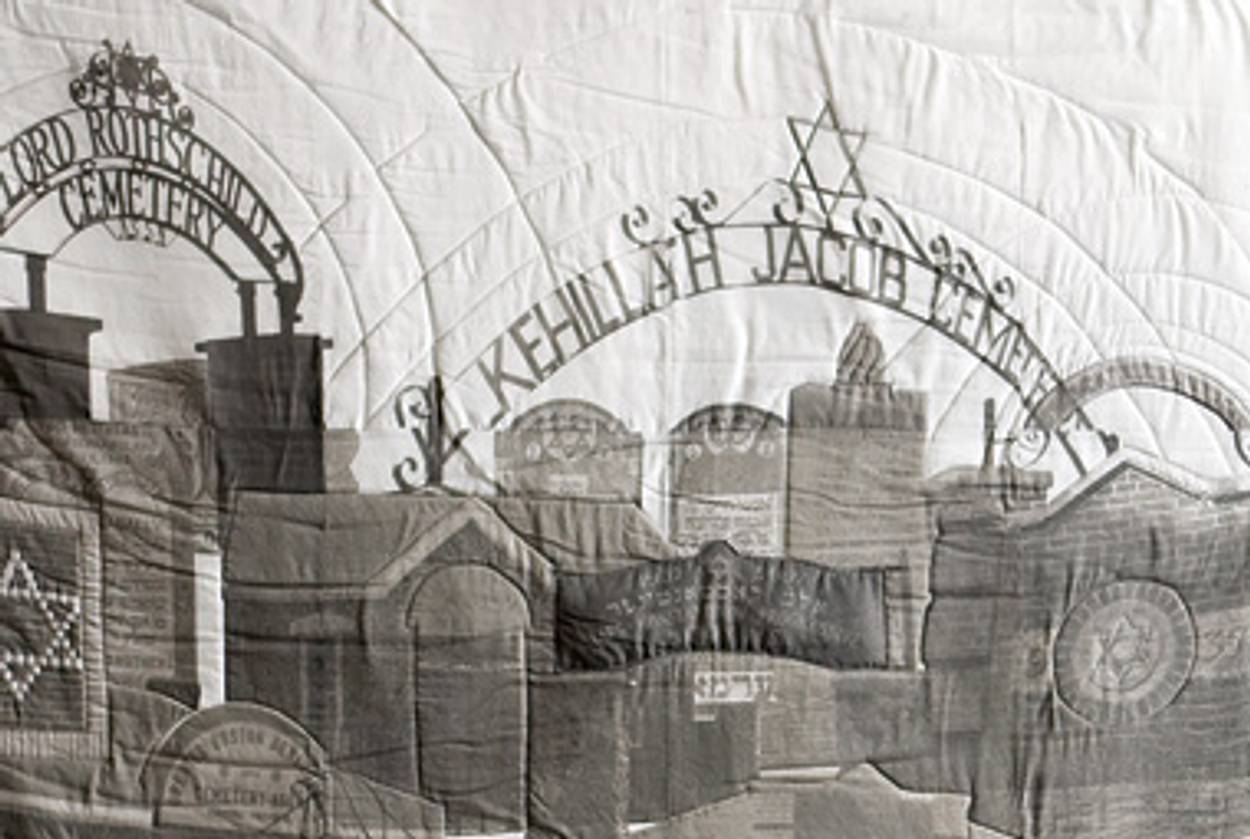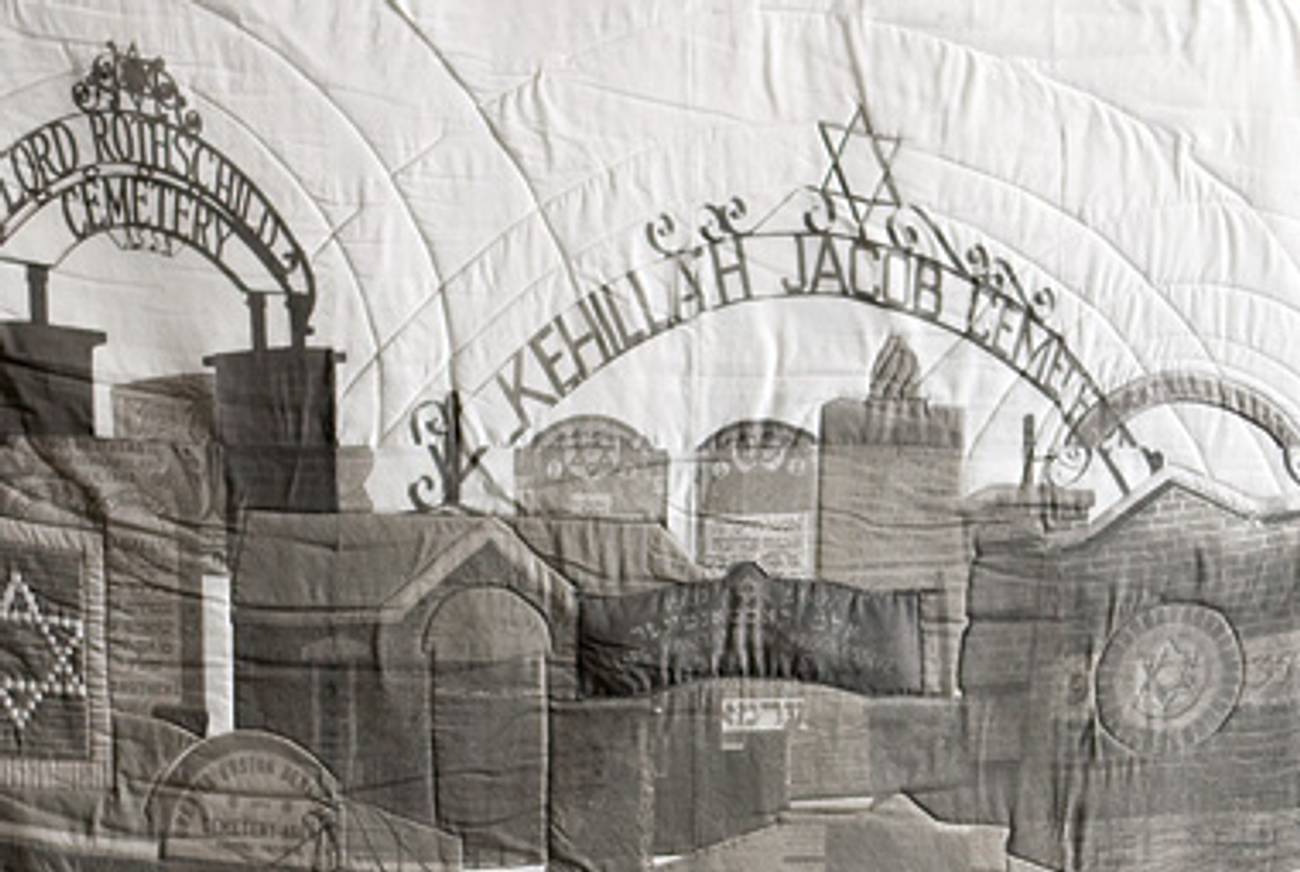Raving Stitches
Hebrew Union’s exhibit of quilts and other textiles highlights an unheralded art and its spiritual messages




The tefillin are silky and sparkly enough to delight any 5-year-old. Instead of the traditional leather straps, these phylacteries, on display at the Hebrew Union College Museum in New York, have long, shiny, blue satin ribbons. The Hebrew letter shin on the headpiece is rendered in electric-blue glitter-thread on a royal-blue background. Instead of a rigid square box, the headpiece is soft and ovoid, edged in gold embroidery and tiny seed pearls. And inside, in addition to the traditional prayers, is a prayer by Einat Ramon, the first Israeli-born woman to be ordained as a rabbi, “designed to remind women of their abilities and inner strength to fulfill their potential.”
Tefillin, of course, are traditionally for men. So these, by Israeli artist Ayana Friedman, could drive your average traditionalist to strangle himself with his own straps, which Friedman has no interest in using anyway because they are made of “dead animal’s skin.”
Not every piece in A Stitch in Jewish Time: Provocative Textiles is quite so provocative. The title is a bit deceptive, as some of the show consists of purely beautiful ritual objects made of fabric and designed by women. But most pieces are thought-provoking, sometimes funny, sometimes very moving.
Historically, textiles haven’t gotten a lot of respect. Sure, they covered the body, decorated the walls, kept folks warm in bed, added a little zhoozh to the floors. But anything having to do with thread or fabric, no matter how intricate, festive, or visually pleasing, was women’s work. Craft. Not until a 1971 Whitney Museum show, called “Abstract Design in American Quilts,” was this traditionally female textile form viewed as art. When quilts were hung on plain white walls, suddenly people saw connections to abstract expressionism, cubism, color-field painting, op-art. As the civil rights and feminist movements gained ground, the textile work of once-anonymous black and poor women was deemed valid.
Some of the women in the Hebrew Union College show are very famous—art-world rock stars Judy Chicago and Miriam Schapiro, members of the pioneering feminist art program at CalArts, are both represented. But it’s wonderful to see works by lesser-known artists, too.
I was particularly drawn to the quilts. My college thesis was on quilting as a metaphor for women’s writing. Bear with me: Eudora Welty used to write snippets of narrative and character description on little pieces of paper, then move them around and pin them together. Her work reappropriates little bits of folktale, fairy tale, Greek myth, and Southern legend, clips them out of context the way a quilter salvages a bit of fabric from a frayed old garment, then creates something entirely new out of the pieces. Other women writers have talked about how they can only write in snippets, piecing things together when their children are napping. Of course, not all women’s writing is about asserting mastery over source material or stitching old things together. But in quilting, for me, the evocative sense of reclaiming a disrespected old feminine art form is always there.
That’s why I loved Esther Kessler Yarinsky’s quilt Gracia (2002), depicting the story of Dona Gracia Nasi, the wealthy 16th-century converso Jew. When her husband died, Dona Gracia took over his businesses, ran a fleet of merchant ships, got even wealthier, helped less-advantaged Jews escape persecution in various countries along her trading routes, and by the time of her death was living openly as a Jew rather than practicing in secret. Yarinsky’s quilt depicts her dressed magnificently, against a background of sea and sky. Embroidered around her are the names of the cities she did business in as well as the Hebrew names of other strong women in our tradition like Devorah and Esther. There are bits of tapestry, lace, traditional quilt-block patterns. It’s exuberant.
Another quilter, Rochelle Rubinstein, uses the Welty-ian strategy of making us see familiar text in a new way. She carves Ezekiel’s lament for Jerusalem, which he calls “a wicked prostitute”—“Oy, oy, lach,” woe, woe to you—on a printmaking block, as well as “Oy, oy li,” woe, woe to me. She prints them over and over in tiny squares over the woodblocked image of a little girl. Who is the girl? Any small girl in a coat tends to remind us of Holocaust victims being rounded up, but she could be any child who hasn’t yet felt the weight of the world’s boxes and constraints.
And Lisa Rosowsky’s Baker Street (2007) quilt made me cry. Made of cotton, silk, and “found tallit,” it’s a photographic collage depicting the West Roxbury cemetery in Massachusetts, where my dad is buried. Many of Rosowsky’s relatives are there too. As she notes in a caption to her work, rather than adhere to the 19th-century idyll that imagined the cemetery as the “sylvan garden,” gravestones in West Roxbury would “huddle and clump, locked in gossip … to me, it feels like home.”
I was drawn to a piece by Carol Hamoy, whose family worked for years in the garment industry, made of vintage white ladies’ gloves. Overlaid and overlapping, they’ve been turned into wings. Embroidered in red over the fluttering fingers is a reference to the book of Exodus, a story of becoming free. Also exploring the idea of freedom is Coat of the Agunot, by Andi Arnovitz, which incorporates digital scans of antique ketubot, Jewish wedding contracts, torn into pieces, tiled, and turned into the fabric of a high-necked, long coat. The hem and sleeves are sewn shut, and multiple threads dangle, reflecting the uncertainty and entrapment of an Agunah, a “chained woman” whose husband will not grant her a get.
Many of the pieces in this show consider the way women’s voices have been silenced or lost. Jane Trigere’s portraits of Orthodox women, using abandoned cushions from an upper Manhattan shul’s balcony seating section and pages of women’s prayer books, are wonderful. Leslie Golomb and Louise Silk‘s trio of quilts take a different tack, reflecting on Southern history and bigotry. Using as their starting point a pre-Civil-War photo of a Southern Jewish family and its slave, Golomb and Silk create a narrative that starts at a seder (the first quilt has a matzoh-patterned background); the slave reflects, in embroidery thread, that this night isn’t different from all other nights for him. (I wasn’t comfortable with the white artists’ attempt to reproduce black speech, but that’s a small flaw in a well-intentioned work.) The next quilt shows the scapegoat ritual from the Book of Leviticus and the slave boy escaping into the wilderness. The third has a repeat pattern of Stars of David, made up of bits of fabric from the previous quilts, reflecting the wish that the boy will follow his own evening star to safety and peace. The juxtaposition of quilt techniques associated with Southern history and tradition and a narrative about Judaism and civil rights is fascinating.
I don’t want to give short shrift to the few men in the show. Adam Cohen shows us an embroidered “laser gun army ant,” using comic book imagery to reflect on childhood, gender roles, and violence; Brooklyn artist Doug Beube creates a shocking suicide bomber vest with the cartridges filled with segments of the New World Atlas instead of explosives, indicating that “words can disseminate propaganda or wisdom.” Robert Forman creates a self-portrait in Huichol-style string painting of himself at different ages, looking at appropriation and self-perception as well as masculinity and Jewishness.
As you no doubt know, there’s a cool trend of “reclaiming” needlework, calling it “not your grandma’s knitting.” Oh, please. Your grandma was awesome. And there’s a whole line of grandmas, a whole tradition, with something to teach you whippersnappers. Calling an apron or sampler “punk rock” does not make it the revolution. On the flip side, there’s a countermovement of young, Waldorfian, stay-at-home mom crafting fiends who eschew punk-rockness and see their work as domestic, womanly, a return to tradition and homespun values. I’d like to take both sides to see this show; it’s proof that textiles can be legitimately insurrectionary and also reflective of woman’s history.
A Stitch in Jewish Time, curated by Laura Kruger, is at the Hebrew Union College museum in New York through June 11, 2011.
Marjorie Ingall is a columnist for Tablet Magazine, and author of Mamaleh Knows Best: What Jewish Mothers Do to Raise Successful, Creative, Empathetic, Independent Children.
Marjorie Ingall is a former columnist for Tablet, the author of Mamaleh Knows Best, and a frequent contributor to the New York Times Book Review.